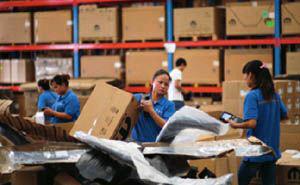FTAAP Is Expected
2014-12-01ByShenMinghuiand
By+Shen+Minghui+and+Liu+Junsheng
In terms of economic scale and the number of regions included, Asia-Pacific Economic Cooperation (APEC) is one of the worlds three major regional cooperation organizations together with the EU and the North American Free Trade Agreement. The annual APEC Economic Leaders Meeting holds great significance for both the region and the world. The Free Trade Area of the Asia-Pacific (FTAAP) will represent a hot topic during this years meeting.
The FTAAP has been advocated for years. In 2004, the APEC Business Advisory Council submitted a proposal to the APEC Economic Leaders Meeting, recommending the establishment of the FTAAP in the hopes of accelerating free trade process and facilitating APEC economies in resuming growth in the aftermath of the Asian financial crisis in 1997. APEC announced in 2006 that it would examine the long-term prospect of an FTAAP. The 2010 APEC Economic Leaders Meeting confirmed that inroads had been made as regards forming the FTAAP, and the leaders declarations announced after the meeting said APEC will further promote regional economic integration and take concrete steps toward the realization of such an area.
Basis and prospects
Asia-Pacific economies are imbalanced in terms of economic, social and political development. The United States lost enthusiasm for the FTAAP when it joined the TransPacific Partnership (TPP) in 2010. However, explorations on economic integration in the Asia-Pacific region, with particular regard to the TPP and the Regional Comprehensive Economic Partnership (RCEP) started in 2012, have laid a solid foundation for the establishment of the FTAAP. Under current conditions, economic integration in the Asia-Pacific region is likely to advance through the TPP and RCEP, both of which will play important parts in the future FTAAP.
The TPP represents institutional cooperation featuring high quality and strong constraints, while the RCEP is a more oriental mechanism—voluntary, flexible, open and less institutional cooperation. The RCEP reflects the local experience of East Asian economies in long-term cooperation and is more suitable to the conditions of East Asian members; it is therefore well accepted and supported by East Asian economies. The TPP and RCEP could represent two complementary pathways to realizing the FTAAP. On one hand, they can finally realize the FTAAP. By 2025, the TPP will bring in$295 billion of annual benefits, while the RCEP will produce $500 billion of benefits each year. On the other hand, these two pathways provide more options to economies in the region.
If the FTAAP is established in the future, it will emphasize both constraints and mutual benefits to distinguish itself from the non-compulsory APEC. It will include super-WTO rules and pursue a high-quality free trade agreement. Covering the whole Asia-Pacific region, the FTAAP will reorganize all the existing bilateral and sub-regional free trade agreements. As a consensus among participating economies, the FTAAP is regarded as an important tool serving the Bogor Goals and facilitating economic integration in the Asia-Pacific region.
Facilitating free trade
Since the 21st century, developing and developed economies have debated trade issues. The outbreak of the global financial crisis in 2008 further gave rise to trade protectionism. Global multilateral trade systems represented by the WTO are short on the strength necessary to address these problems.
According to data from the Global Trade Alert, an independent monitor of policies that affect world trade, the number of cases involving trade protectionism has risen remarkably since the global financial crisis broke out, and in most cases, non-conventional trade protectionist measures have been adopted to avoid sanctions by the WTO. Further, protectionismrelated measures such as trade remedies, export subsidies and discriminative government procurement are increasing, against which the current WTO framework has no effective measures.
The FTAAP will help facilitate the process of global trade liberalization and better address the above problems.
APECs tradition of contributing to world trade talks is long-standing. It has proposed some super-WTO measures such as the liberalization and facilitation of trade and investment as well as early voluntary liberalization.
Since the FTAAP covers North America and East Asia, and given the fact that the worlds economic center is shifting to the Asia-Pacific region, such a large-scale free trade agreement will significantly improve the economic integration in this region and accelerate the process of liberalization under the WTO framework.
More importantly, the FTAAP emphasizes next-generation trade and investment issues as well as negotiations on sensitive issues concerning agriculture, rules of origin and intellectual property rights, areas in which loopholes exist in WTOs supervision of non-conventional trade protectionism. The FTAAP can provide models for further improvements in the above rules and contents.

Revitalizing the APEC
In recent years, the number of regional trade agreements (RTAs) and free trade agreements(FTAs) within APEC has increased rapidly, rising from 70 in 2002 to 257 in 2013. Once an economy enters RTAs or FTAs, its neighboring economies have to join or start new RTA or FTA negotiations in order to avoid the losses caused by trade diversion, thus increasing the number of RTAs and FTAs.
Now in the Asia-Pacific region, various overlapping RTAs and FTAs have become obstacles for the overall development of APEC. Different rules of origin adopted by different RTAs and FTAs have aroused a “spaghetti bowl effect,” a phenomenon in international economic policy referring to the complication that arises from the application of domestic rules of origin in signing FTAs across nations. The effect leads to chaos in the international trade because the same commodity may be subjected to different tariffs due to different rules of origin. This has not only raised operational and supervision costs in regional cooperation but also gone against the APEC principles of trade and investment liberalization and facilitation.
Although the number of RTAs and FTAs is increasing, the number of exporters using the preferential policies of RTAs or FTAs remains unchanged. In the meantime, RTAs and FTAs have also diverted attention of member economies, transferring resources that could otherwise be pledged to APEC negotiations to RTA or FTA negotiations.
The start of the FTAAP process is an important tool to restrain the growth of RTAs and FTAs and reinvigorate APEC. It is expected that the FTAAP can streamline APEC cohesion, in order to prevent more RTAs or FTAs from being signed among developed members owing to their disappointment at the slow progress in trade and investment liberalization within APEC.
Most of the current RTAs and FTAs in the Asia-Pacific region just cover traditional trade and investment fields, while the FTAAP, a kind of free trade area of higher standards, will cover wider ranges, so it will be difficult for various economies to establish similar RTAs or FTAs. This will break the domino effect in joining or establishing RTAs or FTAs and boost economic integration in the Asia-Pacific region and the APEC development in a very real sense.
